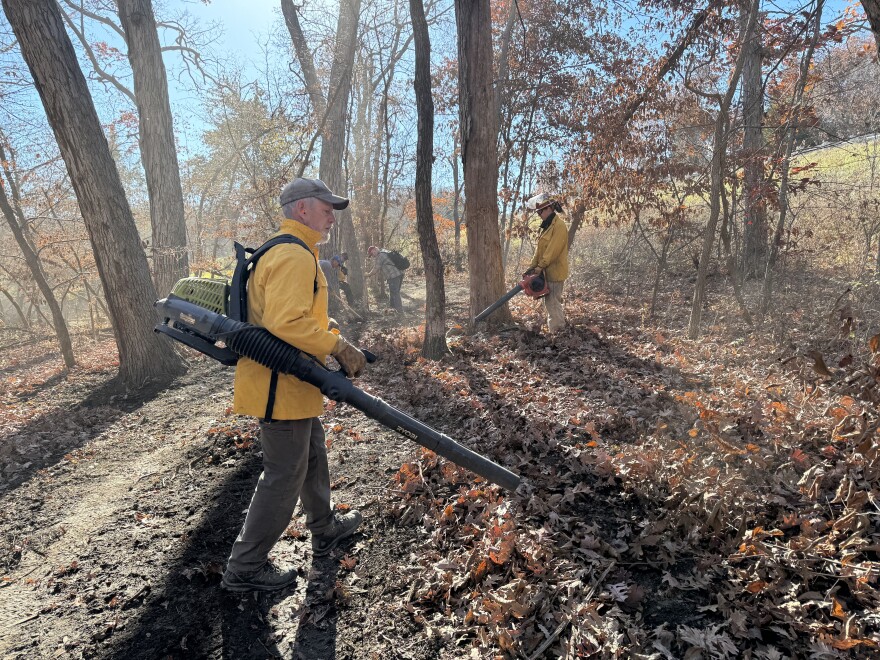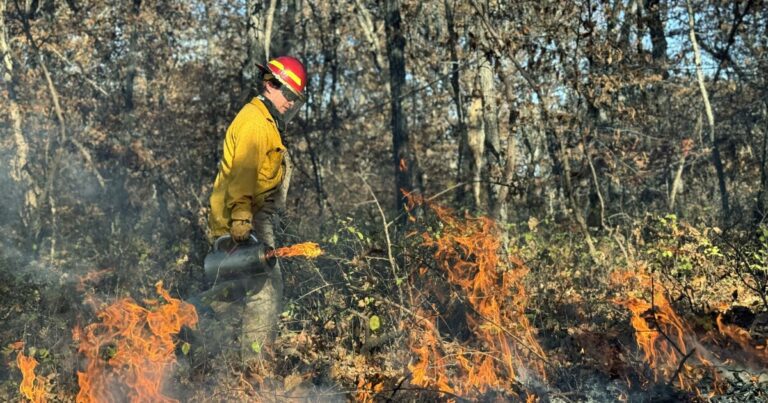DOUGLAS COUNTY – In the Baldwin Woods Forest Reserve south of Lawrence, majestic oaks and willows rise 50 to 100 feet into the air.
But far below their canopy, something worries scientists. Other tree species are gradually crowding out the next generations of this forest's iconic species.
As they do so, they cast more shadow to stabilize their position.
As the understory darkens, the oak and holly saplings struggle. So are many wildflowers. And, eventually, so will the pollinators and other creatures that depend on those plants.
But on Nov. 14, about three dozen scientists, foresters and firefighters worked together to bring back an ingredient missing from nearly 40 acres of those woods: flames.
“It has been a long time”, University of Kansas Field Station said principal Sheena Parsons. “It's a very big step.”
After five years of planning, the controlled burn went smoothly.
This sets the stage for burning this part of the forest floor every half decade or so, and eventually burning other parts of the refuge. It also builds local expertise in an area where more people have experience burning grasslands than forests.

Celia Llopis-Jepsen
/
Kansas News Service
Parsons hopes this will inspire more landowners learn how to use fire to keep forest habitats and wildlife healthy — even to protect against the growing risk of devastating wildfires.
“You can use fire safely,” he said. “It's not just something scary.”
A changing forest
A similar story plays out in the ancient oak forests of eastern North America. One of the continent's key ecosystems needs help.
Acorns and nuts still wet the ground every fall. But without periodic flares at the bottom, success is proving increasingly difficult for these seeds.
Faster-growing species that were once held in check by the flames shoot over young oaks and hemlocks and shade them out.
In much of the eastern US, oak canopies transform into maple forests mixed with beech, birch, poplar or other companions.
In eastern Kansas—the westernmost edge of the continent's oak biome—other species are leading a similar transition. These include blackberries, redbuds, ashes, elms, hops and junipers.
As oak canopies decline in the eastern US, biodiversity may take a hit or change in ways that break the bonds between insects, their host plants, and the rest of the food web.

Celia Llopis-Jepsen
/
Kansas News Service
Meanwhile, other changes are occurring in the forest, where periodic fires once left their mark on soil nutrients, leaf litter accumulation and more.
Scientists are still documenting the consequences, which appear to be significant. National Park Service he says that the shift to maple forests, for example, could mean the loss of a third of the diversity among wildflowers and other soft plants that grow low to the ground. Oak canopies also support more species of birds and insects.
At Baldwin Woods Forest Reserve, thickets of coral have spread everywhere over the years, while its blooms Michigan Lilies became a rarer sight.
“They never bloom because they don't get enough sun,” said Bill Busby, retired zoology professor and director emeritus of the sanctuary.
KU scientists believe periodic fire could also help the wide variety of early spring flowers that characterize healthy oak forests.
They hope it will shrink the large footprint of species like the coral reef.
“We're not trying to get rid of it,” Busby said. “We just want balance.”
Native Americans and fire
Rice Woodland, where the Nov. 14 controlled fire took place, is part of the 460-acre Baldwin Woods Forest Park managed by the Kansas Biological Survey & Center for Ecological Research.

Celia Llopis-Jepsen
/
Kansas News Service
Parts of the area were never cleared. It is a rare stretch of relatively undisturbed, mature oak habitat with centuries, if not millennia, of history. The increasing scarcity of such places led to the area becoming Baldwin Woods national natural landmark.
It is not clear how many decades have passed since a fire last swept through the bottom floor of the shelter.
In the 1800s and earlier, Native Americans set fires here as they did in many forests, woodlands, savannas, and grasslands throughout North America.
Oaks, in particular, have bark and root systems that excel at surviving fire.
Thus, in oak habitats, fires maintained relatively open canopies that allowed forest floors rich in hunting opportunities and full of diverse plants for food and medicine.
After the American government and settlers pressured, deceived and forcibly removed the Native Americans from their lands, they gradually neutralized the fire as well.
Later, generations of Americans grew up with Smokey Bear's motto, “Only you can prevent forest fires.”
Policies that generally suppressed fire actually contributed to making forests more prone to highly destructive, out-of-control flames.

Celia Llopis-Jepsen
/
Kansas News Service
Even fire-starved grasslands have become clogged with brush and trees that can make flames more dangerous, exacerbating the rise of large wildfires in the Great Plains.
In 2001, Smokey Bear's motto was changed to “Only you can prevent fires.” The subtle difference recognizes this prescribed fire not fire — and that it plays a key role in habitat resilience.
A low and slow fire
Luke Berning's job at the Kansas Forest Service focuses on fire prevention — the bad kind. Often this means helping with the good kind.
So on the morning of Nov. 14, she happily hauled equipment into Rice Woodland with the goal of helping her oak trees and fish farms.
“I'm excited,” he said and gestured to the tallest trees in front of him. “In 60, 70, 120 years, when those oaks are old, (there will be) stock to replace them.”
Oak habitats feed and shelter an impressive array of wildlife, including legions of moths, butterflies, hornets, ants and spiders that they support the food web.
Nutrient-rich nuts provide them with protein, fat and minerals every fall as winter approaches. Deer, turkeys, quail, grouse, wood ducks and other creatures flock to this buffet.
The hickory trees common to Baldwin Woods have distinctive curls of peeling bark that create little tents for bats and other critters to call home.
These forests are home to flying squirrels, a species that the Kansas Department of Wildlife has listed as in need of conservation.
Setting fire to the forest required waiting for the right weather. Not too moist or wet, not too dry. Crews needed wind that wasn't too strong or blowing from the wrong direction.

Celia Llopis-Jepsen
/
Kansas News Service
Plans were canceled several times before the weather finally cooperated.
Crews then set out to finish the job they had started much earlier: clearing 8-foot-wide paths down to bare ground to contain the blaze at 39 acres.
They then made their way through the forest, using special torches to light the leaf litter every several feet.
“We don't want any of our flame lengths to exceed three feet,” explained forester EJ Jamison. “Well, he'll just make a nice crawl through the woods in the direction we're aiming for.”
The fire behaved as expected. Results, however, will take months or even years to be seen.
Jamieson hoped the flame would bring enough heat to weaken some of the young hops she saw around her.
“Here we have a bunch of little oak seedlings,” he said, pointing down to a 1-foot-tall chinkapins near her feet — outsiders spring up through a thick layer of leaf litter. “We hope they respond very well.”
Celia Llopis-Jepsen is the Kansas News Service's environmental reporter. You can follow her on Twitter @celia_LJ or email her at celia (at) kcur (dot) org.
Kansas News Service is a collaboration of KCUR, Kansas Public Radio, KMUW and High Plains Public Radio that focuses on health, the social determinants of health and their connection to public policy.
Kansas News Service stories and photos may be republished by the media at no cost with appropriate attribution and a link to ksnewsservice.org.

